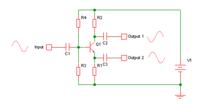boylesg
Advanced Member level 4
- Joined
- Jul 15, 2012
- Messages
- 1,023
- Helped
- 5
- Reputation
- 10
- Reaction score
- 6
- Trophy points
- 1,318
- Location
- Epping, Victoria, Australia
- Activity points
- 11,697
Could some one please explain how you calculate the values of R3 and R6 in this circuit the following circuit.
I had a go at plugging the appropriate values into a Excel spread sheet calculator I have made for transistors in switching mode.
So I chose the maximum output current for my Q2 at 5A and then calculated the required base current using my spreadsheet. That gave me a required base current of 50mA which seems about right according to 2SD2045 datasheet.
Then I used this as the collector current for my BC327 and tried to calculate the required base current and base resistor value using the same spread sheet. That's where I got the erroneous value for the base resistor of BC327.
I came up with value of 100k, or there abouts, for R3 and naturally Q1 and Q2 never switch on in the simulator when I reduce the load resistance to a very low value.
The formulas in my spread sheet were taken from an NPN example I found. So I am presuming that the formulas used for calculating the resistors etc for a PNP transistor a different to those used for NPN transistors.
The values for R3 and R6 in the simulator are based on the values specified in the LM317 datasheet for a high current voltage regulator.
Q2 is an approximation for 2SD2045 that I will actually use in the real circuit.
I had a go at plugging the appropriate values into a Excel spread sheet calculator I have made for transistors in switching mode.
So I chose the maximum output current for my Q2 at 5A and then calculated the required base current using my spreadsheet. That gave me a required base current of 50mA which seems about right according to 2SD2045 datasheet.
Then I used this as the collector current for my BC327 and tried to calculate the required base current and base resistor value using the same spread sheet. That's where I got the erroneous value for the base resistor of BC327.
I came up with value of 100k, or there abouts, for R3 and naturally Q1 and Q2 never switch on in the simulator when I reduce the load resistance to a very low value.
The formulas in my spread sheet were taken from an NPN example I found. So I am presuming that the formulas used for calculating the resistors etc for a PNP transistor a different to those used for NPN transistors.
The values for R3 and R6 in the simulator are based on the values specified in the LM317 datasheet for a high current voltage regulator.
Q2 is an approximation for 2SD2045 that I will actually use in the real circuit.
